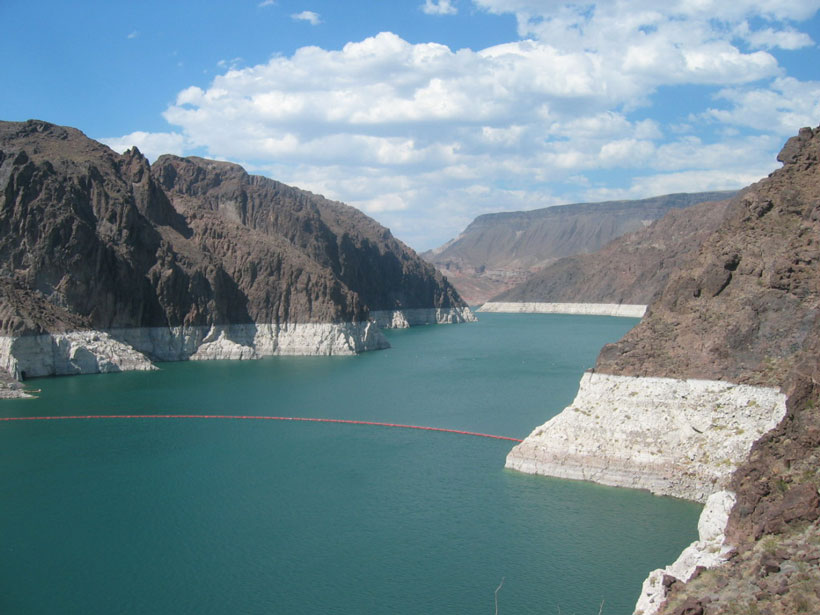Reservoir evaporation represents the only irreversible loss to the water resources system.
Large-scale water storage provides many benefits, including flood control, water supply, recreation, and hydropower. However, reservoirs also contribute to environmental effects and increased water loss due to evaporation. Reservoir evaporation represents the only irreversible loss to the water resources system. For example, preliminary estimates of evaporation from major reservoirs along the Colorado River are of the order of 10% of the system-wide natural flow.
Predicted water shortages in arid regions of the western United States increase the need for conservation, efficiency, and monitoring. A changing climate also creates the need for better modeling, moving beyond relatively crude methods toward more sensitive representations of atmospheric and reservoir conditions.
The Reservoir Evaporation Workshop brought together recognized experts in atmospheric science and hydrology, along with land and water resource managers, to discuss current practices and conservation issues, with the goal of developing a science plan of action to improve estimates of reservoir evaporation. The workshop focused on reservoirs in western North America, and attendees representing the Colorado River system, California, Nevada, and Saskatchewan made presentations.
Measuring evaporation is complex, a fact made evident by the multitude of methods and attempts to quantify evaporation that were covered at the workshop, including operational methods and state-of-the-art research techniques. The mismatch between current practices and available tools to quantify evaporation was largely attributed to the lack of use and understanding of state-of-the-art observing and modeling techniques. This mismatch points to the necessity of implementing up-to-date tools into current operations in order to address current and future water shortages.
Presenters posed a series of questions related to reservoir evaporation to attendees, and their responses were recorded. Major themes included identifying knowledge and logistical gaps, desired routine observations and monitoring, and the usability of reservoir evaporation forecasts.
Outcomes from the workshop included recommendations for a long-term research program with these next steps:
- provide a rigorous assessment of current practices and needs for estimating reservoir evaporation
- quantify the evaporation of current reservoirs and deliver scientific guidance for reducing evaporation in current or enlarged reservoirs
- develop a community model for reservoir evaporation based on existing lake or reservoir models from within the hydrologic, limnologic, and atmospheric fields
- introduce research-to-operations practical methods to monitor and forecast reservoir evaporation, involving a process of coproduction of research wherein scientific research is driven by operational needs (operations-to-research)
- develop a scientific plan using state-of-the-art methods and instrumentation to investigate reservoir evaporation monitoring and forecasting and initiating the transfer of this technology to the water management community
Conservation at the source strategically moves and stores water in areas of least evaporation.
Last, the concept of conservation at the source was introduced. This approach assesses evaporation rates of current reservoirs and provides scientific guidance for large reservoir systems to strategically move and store water in areas of least evaporation.
With more than 6800 reservoirs and dams in operation globally, improvements in scientific understanding, modeling, monitoring, and operational guidance will be of broad relevance. Additional information on workshop goals, participants, and presentations is available at the workshop Web page.
We acknowledge the University of Colorado at Boulder for hosting and the vice chancellor of research for supporting the workshop. The workshop was made possible with the support of the two co-organizers: Justin Huntington of the Desert Research Institute and Robert Grossman of the University of Colorado.
—Ben Livneh, Department of Civil, Environmental, and Architectural Engineering and Cooperative Institute for Research in Environmental Science, University of Colorado, Boulder; email: [email protected]; Katja Friedrich, Department of Atmospheric and Oceanic Sciences, University of Colorado, Boulder; and Peter D. Blanken, Department of Geography, University of Colorado, Boulder
Citation: Livneh, B., K. Friedrich, and P. D. Blanken (2016), New interest in reservoir evaporation in western United States, Eos, 97, doi:10.1029/2016EO048679. Published on 23 March 2016.
Text © 2016. The authors. CC BY-NC 3.0
Except where otherwise noted, images are subject to copyright. Any reuse without express permission from the copyright owner is prohibited.

